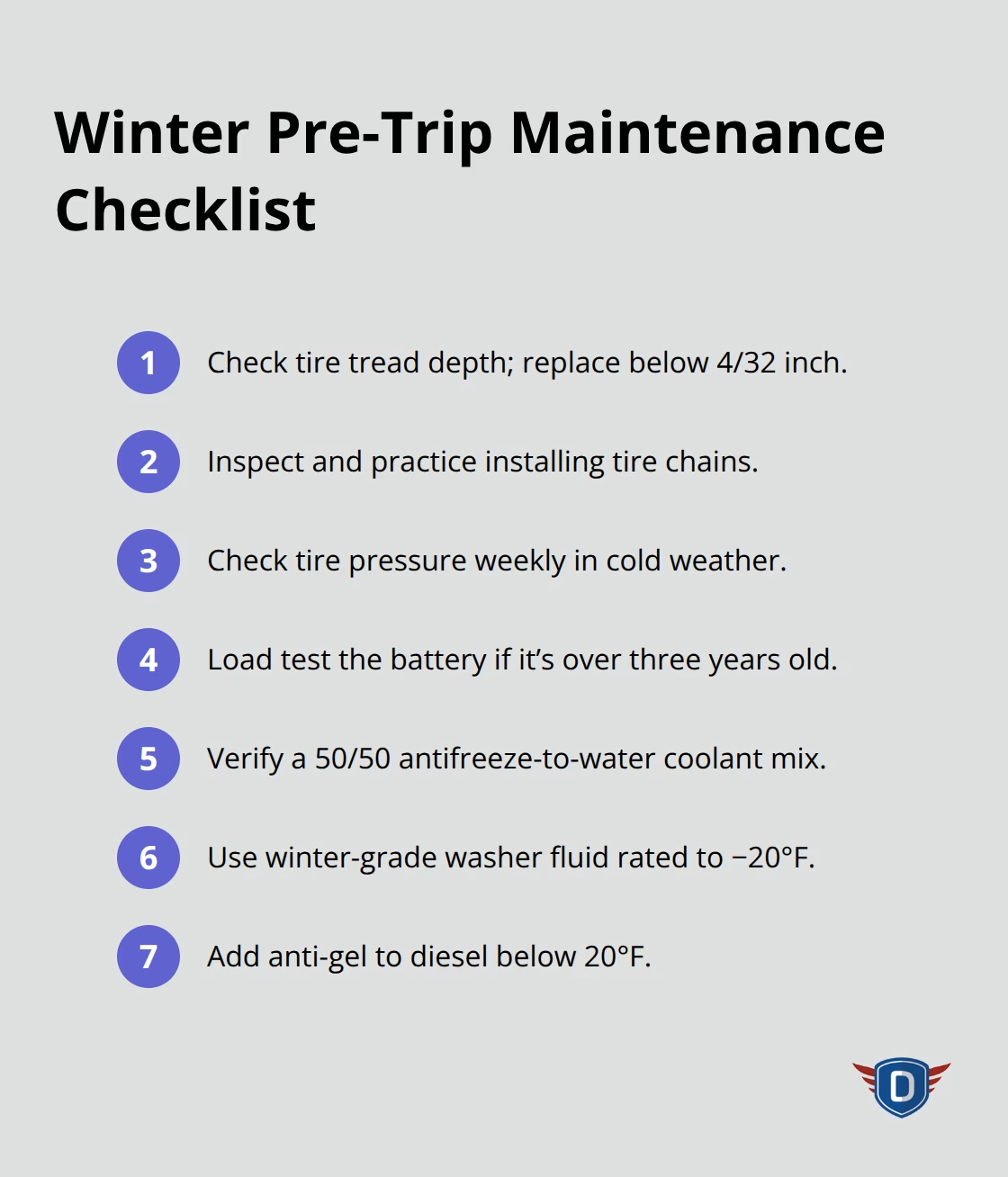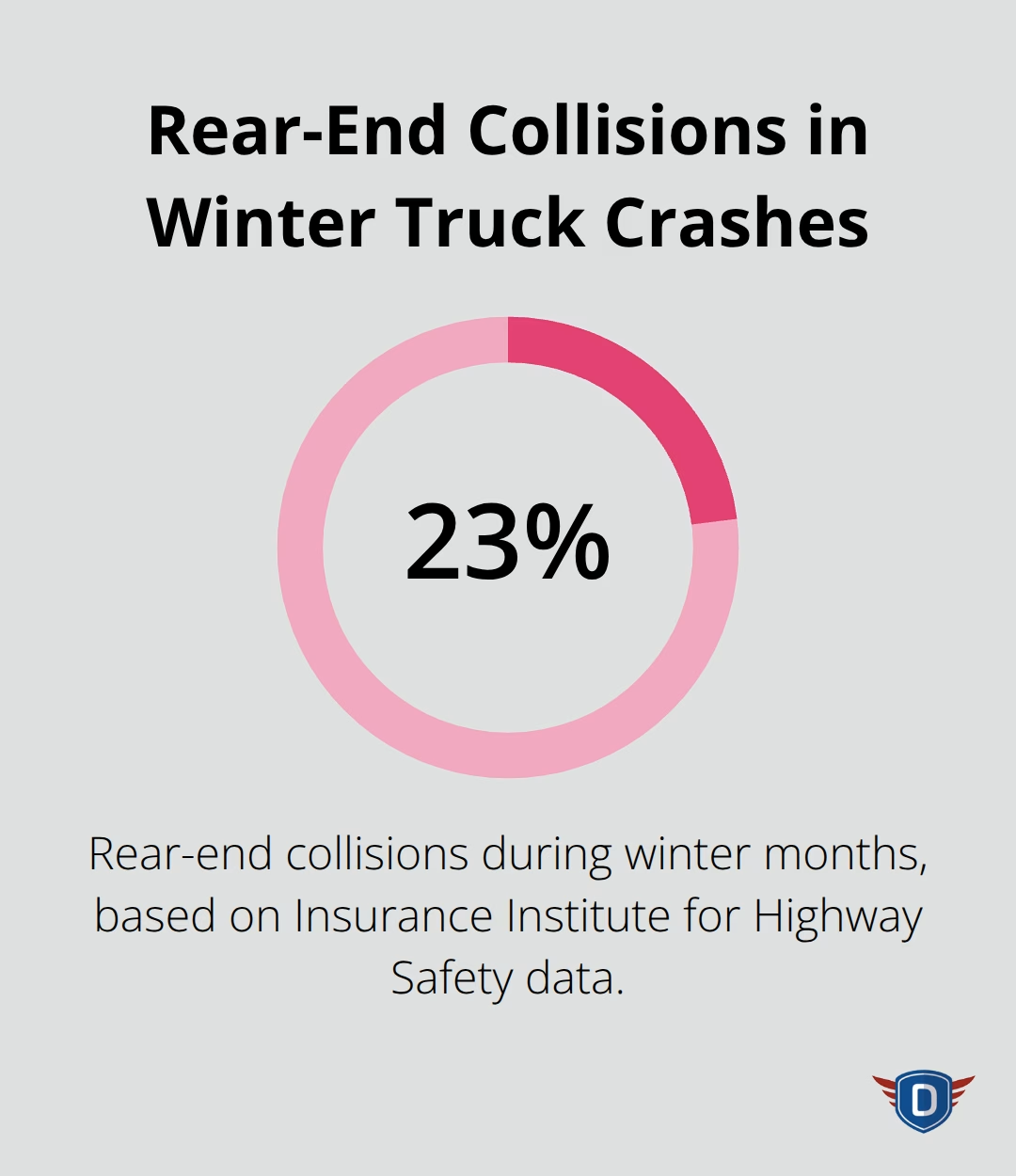Winter conditions create deadly hazards for truck drivers across the country. The Federal Motor Carrier Safety Administration reports that weather-related crashes increase by 70% during winter months.
At floridadetscourse.com, we know that proper preparation and technique can save lives. These winter driving safety tips for truck drivers will help you navigate dangerous conditions and return home safely.
What Should You Check Before Winter Driving?
Tire and Chain Inspection
Winter tires offer better grip in snow and on ice, outperforming most all-season tires. Check tread depth with the penny test – Lincoln’s head should disappear when you insert it upside down into the tread grooves. Tires with less than 4/32 inch tread depth perform poorly on snow and ice.
Inspect tire chains for broken links, damaged cross-chains, and proper fit. Store chains in an accessible location and practice installation in good weather. Cold weather reduces tire pressure by one PSI for every 10-degree temperature drop, so check pressure weekly during winter months.
Battery and Fluid Maintenance
Cold temperatures can slow down the chemical reaction inside the battery, which allows it to create power. Load test your battery before winter arrives – batteries older than three years fail more frequently in cold conditions. Check coolant mixture with a hydrometer to prevent freezing. The ideal antifreeze-to-water ratio is 50/50 for protection down to minus 34 degrees.
Inspect windshield washer fluid and use winter-grade fluid rated to minus 20 degrees. Check engine oil viscosity – use 5W-30 or 0W-30 oil for better cold-weather flow. Diesel fuel requires anti-gel additives when temperatures drop below 20 degrees Fahrenheit.

Emergency Kit Essentials
Pack a winter emergency kit with 72 hours of supplies. Include extra blankets, non-perishable food, water bottles that won’t freeze, a first-aid kit, flashlight with extra batteries, ice scraper, snow brush, tow strap, reflective triangles, and flares. Keep a cell phone charger and portable battery pack.
Add sand or cat litter for traction under wheels. Store these items in an insulated container to prevent freezing. The National Highway Traffic Safety Administration reports that proper emergency preparation reduces winter breakdown response time by 40%.
Once you complete these pre-trip preparations, you can focus on the specific safe winter driving techniques that will keep you safe on winter roads.
How Do You Master Winter Truck Driving Techniques?
Distance Calculations for Winter Roads
Winter conditions demand precise distance calculations that most drivers calculate incorrectly. The Federal Motor Carrier Safety Administration recommends drivers increase their distance to 15 seconds minimum on icy roads, but experienced drivers know this distance falls short for heavy trucks. A loaded semi that travels 45 mph needs 525 feet to stop on dry pavement – that distance triples on icy roads. Count seconds with the one-thousand-one method while you watch fixed objects like signs or bridges. When the vehicle ahead passes your reference point, you should reach 15 seconds before you pass the same spot. This technique prevents rear-end collisions that account for 23% of all truck crashes during winter months (according to the Insurance Institute for Highway Safety).

Engine Brake Shutdown and Threshold Methods
Turn off your engine brake immediately when winter conditions appear – this single adjustment prevents more jackknife accidents than any other technique. Engine brakes create uneven wheel loads that break traction on slippery surfaces. Use threshold methods instead by applying steady, firm pressure just below the point where wheels lock up. Feel for the brake pedal’s feedback and maintain constant pressure rather than pump the brakes. Anti-lock systems work differently in trucks than cars due to weight distribution, so practice recognition of the pulse sensation during controlled stops. Professional drivers reduce speed to 35 mph maximum on snow-covered highways and 25 mph on ice (regardless of posted limits).
Hill and Curve Navigation Tactics
Attack hills with momentum by building appropriate speed on the approach rather than acceleration uphill. Maintain steady throttle pressure and avoid sudden inputs that break traction. Descend hills in a lower gear to control speed without excessive brake use – use one gear lower than you used to climb up. Sharp curves require speed reduction to 15 mph below normal conditions because centrifugal force increases dramatically on slippery surfaces. Trucks take curves too fast in winter conditions and face increased rollover risk compared to dry conditions.
Weather-related hazards present additional challenges that require specific recognition and response strategies to maintain safety on winter roads.
How Do You Handle Dangerous Weather Conditions?
Black Ice Recognition and Response
Black ice forms when temperatures hover near 32 degrees Fahrenheit, particularly on bridges, overpasses, and shaded road sections that freeze first. Professional drivers identify black ice by watching for a glossy, wet appearance on asphalt that looks different from normal wet pavement. Weather-related conditions create significant safety challenges for commercial vehicle operators, as documented in federal crash statistics.
Test road conditions by gently tapping brakes at low speeds – if you feel the truck slide even slightly, black ice exists. When you encounter black ice, avoid sudden movements and maintain steady throttle pressure. Any abrupt action causes immediate loss of control. Experienced drivers reduce speed to 20 mph when black ice conditions exist, regardless of traffic flow.
Storm Visibility Management
Snowstorms reduce visibility below safe distances within minutes. Federal safety guidelines address conditions where drivers may find themselves operating in reduced visibility situations, but truck drivers need half-mile visibility minimum for safe operation. Turn on low-beam headlights and four-way flashers to increase your visibility to other vehicles. High beams reflect off snow and create worse visibility conditions.
Clean snow from mirrors, windows, and lights every two hours during active snowfall – accumulated snow reduces visibility by 40% according to safety studies. Pull over immediately when you cannot see tail lights of vehicles 200 feet ahead. Professional drivers use truck stops or rest areas rather than highway shoulders because stopped trucks create collision hazards for traffic.
Strategic Weather Decisions
Weather conditions change rapidly during winter storms, and drivers must make decisions before conditions become life-threatening. Monitor weather radar apps and National Weather Service alerts every 30 minutes during winter travel. Stop when sustained winds exceed 45 mph with an empty trailer or 35 mph with a loaded trailer – these wind speeds create rollover conditions.

Temperature drops of 10 degrees in one hour indicate rapidly deteriorating road conditions that require immediate action. Choose truck stops over highway shoulders because winter truck fatalities frequently occur when vehicles strike stopped trucks. Contact dispatch immediately when you stop for weather – communication prevents customer complaints and demonstrates professional decision-making.
Final Thoughts
Weather-related crashes increase by 70% during winter months, but proper preparation and technique prevent most accidents. Professional truck drivers who apply these winter driving safety tips for truck drivers consistently reduce their accident risk and protect their careers. Temperature changes, road surface conditions, and visibility factors change rapidly during winter storms.
Pre-trip inspections, emergency kit preparation, and equipment maintenance form the foundation of winter safety. Distance calculations, engine brake management, and speed reduction techniques keep you in control when conditions deteriorate. Recognition of black ice, visibility management, and strategic decisions about when to stop protect you from weather-related hazards that claim lives each year.
Professional drivers understand that winter conditions demand respect and conservative decisions before situations become life-threatening. We at floridadetscourse.com provide comprehensive training programs that help drivers master these techniques through hands-on instruction. Winter driving skills require continuous practice and education that protects you and other road users throughout your career.







